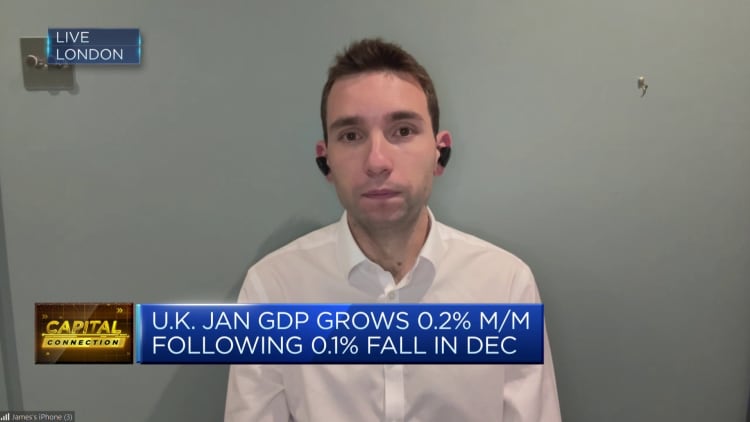Plane contrails streak across the sky over Regent Street on February 15, 2024 in London, England.
Dan Kitwood | Getty Images
U.K. inflation came in lower than expected at 3.4% year-on-year in February, official figures showed Wednesday, down from 4% in January and its lowest point since September 2021.
Month-on-month, the headline consumer price index rose by 0.6%, returning to positive territory after a -0.6% reading in January.
Economists polled by Reuters had expected an annual rate of 3.5% for February and a monthly rate of 0.7%, according to LSEG data.
The Office for National Statistics said the largest downward contributions came from food, restaurants and cafes, while the largest upward pressure came from housing and fuel.
Prices for food and non-alcoholic beverages rose by 5% year-on-year in February, down from 7% in January and the lowest annual rate since January 2022, the ONS said.
“The rate has eased for the eleventh consecutive month from a recent high of 19.2% in March 2023, the highest annual rate seen for over 45 years,” it added.
The closely watched core CPI figure — which excludes volatile food, energy, alcohol and tobacco prices — came in at an annual 4.5%, below a consensus estimate of 4.6% and down from 5.1% in January.
“We have turned a corner on inflation and that means that we can start to look at the conditions for boosting growth, which is ultimately what we all want to see,” Gareth Davies, exchequer secretary to the U.K. Treasury, told CNBC on Wednesday.
But despite the forecasts indicating that CPI will return to target in the coming months, Davies insisted the government was “not complacent whatsoever.”
“We have to work with the Bank of England who have the principal lever to bring inflation down through interest rates, we have to ensure that our fiscal policy aligns with that monetary policy to keep it going down to the target of 2%,” he added.
The Bank of England expects headline inflation to fall temporarily back to its 2% target in the second quarter before increasing again later in the year, after hiking interest rates aggressively over the last two years in order to get prices under control.

The central bank meets on Thursday to decide its next monetary policy move and is widely expected to keep interest rates unchanged at 5.25% as it weighs when to begin cuts.
“Following a torrid couple of years for U.K. households, this morning’s inflation print is yet further evidence that the outlook for consumers is brightening,” Zara Nokes, global market analyst at JPMorgan Asset Management, said in an email Wednesday.
She suggested that, the central bank would undoubtedly cheer the headline figure, but is unlikely to be convinced that “the battle against inflation is won.”
“More good news should be on the way with headline inflation likely to drop below the 2% inflation target in the Spring, but crucially, this is largely being driven by a transitory fall in energy prices,” Nokes added.
“The Bank will instead be keeping a watchful eye on the medium-term inflation outlook, particularly the domestically-generated inflation originating from the services sector.”
Credit: Source link














